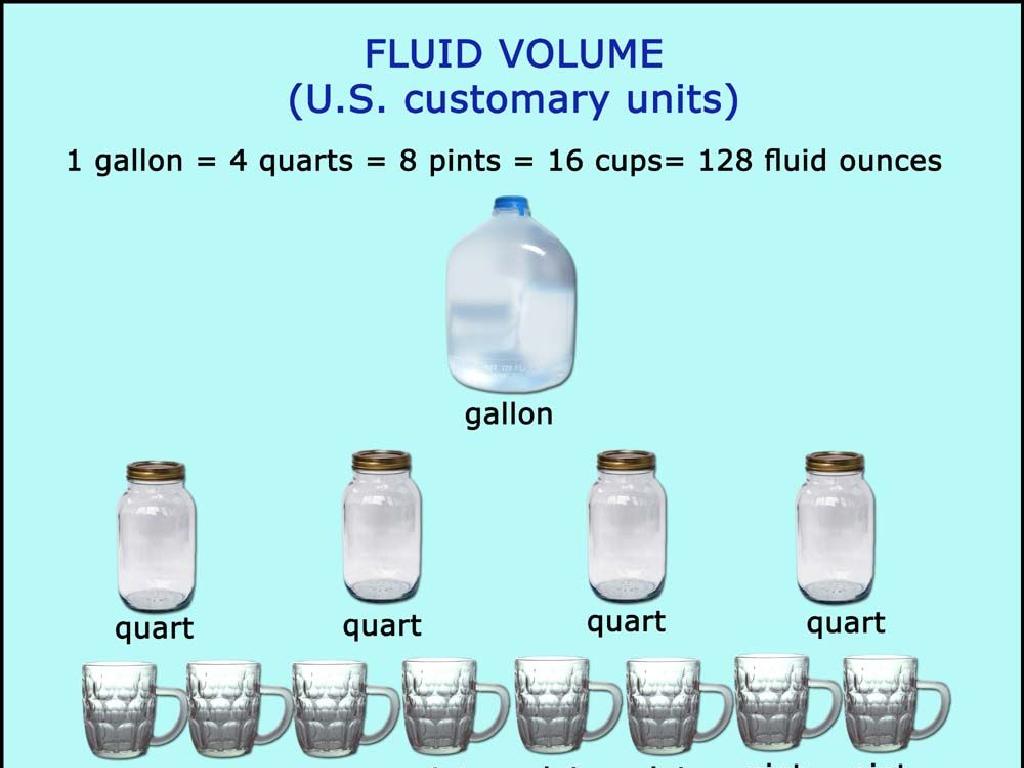Properties Of Polygons
Subject: Math
Grade: Fifth grade
Topic: Polygons
Please LOG IN to download the presentation. Access is available to registered users only.
View More Content
Exploring Polygons
– What is a Polygon?
– A shape with straight sides and no gaps or overlaps.
– Polygons in the Real World
– Think of stop signs, frames, or tiles.
– Polygon Properties
– Number of sides equals number of angles.
– Classifying Polygons
– Sort by sides: triangle (3), quadrilateral (4), etc.
|
Begin with a basic definition of polygons, emphasizing that they are 2-dimensional shapes with straight sides that are fully closed. Provide relatable examples that students can easily recognize from their daily lives, such as stop signs (octagons) or picture frames (rectangles). Explain that all polygons have properties such as equal numbers of sides and angles, which can be used to understand and classify them. Encourage students to classify polygons based on the number of sides they have, starting with triangles and moving up. This slide sets the foundation for understanding more complex concepts related to polygons.
Defining Polygons
– Polygons are 2D shapes
– Think squares and triangles
– Must be a closed figure
– Like a loop, it connects back to start
– No curved sides allowed
– Sides name the polygon
– Triangles have 3, quadrilaterals have 4
|
Introduce the concept of polygons by explaining they are two-dimensional shapes with straight sides. Emphasize that polygons must be closed figures, meaning the sides connect back to the beginning without gaps. Clarify that polygons do not have curved sides; all sides are straight. Discuss how the number of sides a polygon has determines its name, such as a triangle with three sides or a quadrilateral with four sides. Use visual aids to help students identify and count the sides of various polygons. Encourage students to draw their own polygons and share with the class.
Exploring Polygon Types
– Triangles have 3 sides
– Example: Equilateral, Isosceles, Scalene
– Quadrilaterals have 4 sides
– Example: Square, Rectangle, Rhombus
– Pentagons have 5 sides
– Example: Regular pentagon with equal sides
– Hexagons have 6 sides
– Example: Regular hexagon like a honeycomb
|
This slide introduces students to the basic classification of polygons based on the number of sides they have. Starting with triangles and moving up to hexagons, each type of polygon is defined by the count of its edges. Provide examples for each category to help students visualize and remember the shapes. For instance, triangles can be equilateral, isosceles, or scalene, while quadrilaterals include familiar shapes like squares and rectangles. Encourage students to think of other polygons with more sides and to explore the patterns in naming them (e.g., ‘hepta-‘ for 7, ‘octa-‘ for 8). This will set a foundation for understanding the properties and classification of polygons in geometry.
Exploring Properties of Polygons
– Polygons: vertices, edges, angles
– Points where sides meet are vertices. Edges are sides, and angles are inside.
– Interior angles sum varies
– More sides mean more interior angle sum. Like a triangle has 180°.
– Regular vs. Irregular Polygons
– Regular polygons have equal sides and angles. Irregular ones do not.
– Convex vs. Concave Polygons
– Convex polygons have no dents. Concave polygons have at least one dent inward.
|
This slide introduces students to the basic properties of polygons. Start by explaining that polygons are shapes with straight sides. Discuss vertices (corners), edges (sides), and angles (space between edges). Highlight how the sum of the interior angles increases with the number of sides, providing a formula if appropriate. Differentiate between regular polygons, which have all sides and angles equal, and irregular polygons, which do not. Finally, explain that convex polygons bulge outward with all interior angles less than 180°, while concave polygons have at least one angle greater than 180°, creating an inward ‘dent’. Use visual aids to help students identify these properties in various polygons.
Exploring Regular Polygons
– All sides have equal length
– All angles are equal
– Equilateral triangle example
– A triangle with 3 equal sides
– Square as an example
– A 4-sided shape with equal sides
|
This slide introduces students to the concept of regular polygons, which are shapes with all sides and angles equal. Emphasize that in regular polygons, not only is the length of the sides the same, but the measure of each angle is also identical. Use an equilateral triangle, which has three sides of the same length and three equal angles of 60 degrees each, as an example. Similarly, discuss a square, which has four sides of the same length and four equal angles of 90 degrees each. Encourage students to think of other regular polygons and how they might look. This will help them understand the properties that define regular polygons and differentiate them from irregular ones.
Exploring Irregular Polygons
– Irregular polygons have varied sides
– Their angles have different measures
– Example: Scalene triangle
– A triangle with all sides of different lengths
– Example: Rectangle
– A four-sided figure with unequal adjacent sides
|
This slide introduces students to the concept of irregular polygons, which are polygons that do not have all sides of equal length or all angles of equal measure. Unlike regular polygons, irregular polygons can have a combination of side lengths and angles. For example, a scalene triangle, where each side is a different length, and a rectangle, which has equal opposite sides but different adjacent sides, are both irregular polygons. Encourage students to think of other examples of irregular polygons and discuss how they can identify them. This will help students recognize and differentiate between regular and irregular polygons in geometry.
Angles in Polygons: Understanding the Formula
– Interior angles sum formula
– Sum of angles = (n-2) × 180°
– ‘n’ represents sides of polygon
– For a triangle (n=3), sum is 180°
– Calculate for a pentagon
– A pentagon has 5 sides, let’s calculate
– Practice with different polygons
|
This slide introduces the formula for calculating the sum of interior angles in polygons and explains the variable ‘n’ as the number of sides. Start by discussing the formula and how it is derived (subtracting 2 from the number of sides and then multiplying by 180°). Use a triangle as the simplest polygon to illustrate the formula, where the sum of angles is always 180°. Then, as a class activity, calculate the sum of interior angles for a pentagon together. Encourage students to apply the formula to other polygons, such as squares and hexagons, to reinforce their understanding. Provide additional practice problems for homework where students can calculate the sum of interior angles for various polygons.
Polygon Classification Activity
– Classify polygons: regular or irregular
– Count sides and vertices
– Remember: sides are the lines, vertices are the corners
– Calculate sum of interior angles
– Use formula: (n-2) × 180°, where n is the number of sides
– Activity: Practice with examples
– Try classifying shapes in groups and compare answers
|
This activity slide is designed to engage students in hands-on learning about polygons. Start by explaining the difference between regular (all sides and angles equal) and irregular polygons. Then, guide students to count the sides and vertices of various polygons. Next, teach them the formula for calculating the sum of interior angles of a polygon, which is (number of sides – 2) multiplied by 180 degrees. Finally, set up an activity where students practice these skills with a set of example polygons. Encourage group work to foster discussion and peer learning. Prepare to assist students who may struggle with the concepts and provide additional examples if needed.
Class Activity: Create Your Polygon
– Build a polygon with straws
– Polygon must have 5+ sides
– Classify your polygon
– Is it a pentagon, hexagon, etc.?
– Calculate interior angles
– Use formula (n-2)×180° for sum of angles
|
This hands-on activity is designed to help students understand the properties of polygons by constructing one. Provide straws and connectors for the students to build their polygons. Remind them that a polygon must have at least three straight sides, but for this activity, they should create shapes with five or more sides. Once constructed, guide them to classify their polygon based on the number of sides it has (pentagon for 5 sides, hexagon for 6, etc.). Then, teach them to calculate the sum of the interior angles using the formula (n-2)×180°, where ‘n’ is the number of sides. This will help them understand the relationship between the number of sides and the sum of interior angles. Prepare to assist students who may have difficulty with the construction or calculation part of the activity.






